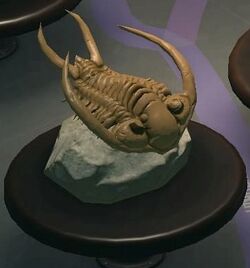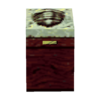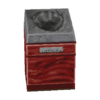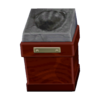Difference between revisions of "Trilobite"
Trig Jegman (talk | contribs) m |
SuperHamster (talk | contribs) (→In {{NH|short|nolink}}: Add NH room) |
||
| (26 intermediate revisions by 11 users not shown) | |||
| Line 1: | Line 1: | ||
{{Infobox Fossil | {{Infobox Fossil | ||
| − | |name = | + | |name = trilobite |
| − | |ja-name= さんようちゅう | + | |ja-name = さんようちゅう |
| − | |ko-name= 삼엽충 | + | |ko-name = 삼엽충 |
| − | |zh-name= 三叶虫 | + | |zh-name = 三叶虫 |
| − | |zht-name= 三葉蟲 | + | |zht-name = 三葉蟲 |
| − | |fr-name= Trilobite | + | |fr-name = Trilobite |
| − | |es-name= Trilobites | + | |es-name = Trilobites |
| − | |it-name= Trilobite | + | |it-name = Trilobite |
| − | |de-name= Trilobit | + | |de-name = Trilobit |
| − | |nl-name= Trilobiet | + | |nl-name = Trilobiet |
| − | |ru-name= Трилобит | + | |ru-name = Трилобит |
| − | |image = | + | |image = NH Trilobite Museum.jpg |
| − | |caption = The | + | |caption = The trilobite in the museum in {{NH|nolink}}. |
| − | |price = 1,300 [[ | + | |scientific name = Cheirurus |
| + | |type = Standalone | ||
| + | |price = 1,300 [[Bell]]s | ||
}} | }} | ||
| − | The ''' | + | The '''trilobite''' is a standalone [[fossil]] in the {{SER}} introduced in {{DnM}} that appears in all subsequent games to date. |
==At the museum== | ==At the museum== | ||
===In {{PG|nolink}}=== | ===In {{PG|nolink}}=== | ||
| − | + | {{PGFossilGroup | |
| − | + | |name={{PAGENAME}} | |
| − | + | |description=Well, what do we have hoo? A trilobite, if I'm not terribly mistaken. Yes, yes. Very nice indeed. This is quite a beautiful specimen, as well. Quite! You're to be congratulated! Well then, where to begin? Trilobites...Ah, yes...Trilobites were hard-shelled segmented arthropods, which populated the Paleozoic seas long before dinosaurs existed. There were over 15,000 species of known trilobites, and more are discovered each year, wot wot! This makes them the single most diverse group of extinct organisms ever! Amazing! Truly remarkable, you know! They are, however, extinct: no living descendants whatsoever. The constant perils of nature and quite formidable indeed.}} | |
===In {{WW|short|nolink}}=== | ===In {{WW|short|nolink}}=== | ||
| − | + | {{WWFossilGroup | |
| − | + | |name=Trilobite | |
| − | + | |description=Hoo my, simply marvelous! This fossil is an outstanding specimen. Trilobites existed long before the dinosaurs, I'll have you know. At the time, there were very few enemies, so they absolutely thrived, wot! For protection, much like a...blech...[[pill bug]], they would roll up into a ball. Oh, forgive my babbling! The very thought of these beasts gets me atwitter!}} | |
===In {{CF|short|nolink}}=== | ===In {{CF|short|nolink}}=== | ||
[[File:CFMuseumTrilobite.jpg|thumb|right|The Trilobite in the museum in {{CF|short|nolink}}.]] | [[File:CFMuseumTrilobite.jpg|thumb|right|The Trilobite in the museum in {{CF|short|nolink}}.]] | ||
| − | + | {{CFFossilGroup | |
| + | |name=Trilobite | ||
| + | |description=Hoo, this fossil is a truly outstanding specimen! Trilobites were around long before the age of the dinosaurs, eh wot? They were quite numerous, and as a result, much research has been done on these fellows. In point of fact, scientists date geological strata based on them. It's almost like they're your guides for time traveling!}} | ||
| − | + | {{Clear|right}} | |
===In {{NL|short|nolink}}=== | ===In {{NL|short|nolink}}=== | ||
| Line 43: | Line 47: | ||
|name=Trilobite | |name=Trilobite | ||
|description=Trilobites were ancient and extinct before the dinosaurs ever appeared! It boggles the mind! Hoo! They were also one of the most successful classes of animal ever, existing for over 300 million years. Some 50,000 species have been identified in sizes ranging from three millimeters to over two feet! Alas, that is the very limit of my enthusiasm for them, though, they look rather too much like bugs. | |description=Trilobites were ancient and extinct before the dinosaurs ever appeared! It boggles the mind! Hoo! They were also one of the most successful classes of animal ever, existing for over 300 million years. Some 50,000 species have been identified in sizes ranging from three millimeters to over two feet! Alas, that is the very limit of my enthusiasm for them, though, they look rather too much like bugs. | ||
| − | |room=1 | + | |room=1}} |
| − | }} | ||
==As an item== | ==As an item== | ||
| Line 50: | Line 53: | ||
{{PGFossilInfo | {{PGFossilInfo | ||
| number = 25 | | number = 25 | ||
| − | | name = | + | | name = trilobite |
| image = Trilobite PG Model.png | | image = Trilobite PG Model.png | ||
| sell = 1300 | | sell = 1300 | ||
| Line 58: | Line 61: | ||
}} | }} | ||
| − | ===In {{WW|short|nolink}} | + | ===In {{WW|short|nolink}}=== |
| − | {| | + | {{WWFossilInfo |
| − | | | + | | number = 10 |
| − | + | | name = trilobite | |
| − | + | | image = Trilobite WW Model.png | |
| − | + | | sell = 1300 | |
| − | + | | color1 = Gray | |
| − | + | | color2 = Brown | |
| − | | | + | | theme = Old-school |
| − | | Trilobite | + | | width = 1.0 |
| − | | | + | | length = 1.0 |
| − | | | + | | hra = 300 |
| − | | | + | }} |
| − | | 1 | + | |
| − | + | ===In {{CF|short|nolink}}=== | |
| + | {{CFFossilInfo | ||
| + | | number = 10 | ||
| + | | name = trilobite | ||
| + | | image = Trilobite CF Model.png | ||
| + | | sell = 1300 | ||
| + | | color1 = Gray | ||
| + | | color2 = Brown | ||
| + | | theme = Retro | ||
| + | | width = 1.0 | ||
| + | | length = 1.0 | ||
| + | | hra = 300 | ||
| + | }} | ||
| + | |||
| + | ===In {{NL|short|nolink}}=== | ||
| + | {{NLFossilInfo | ||
| + | | name = trilobite | ||
| + | | image = Trilobite NL Model.png | ||
| + | | sell = 1300 | ||
| + | | color1 = Gray | ||
| + | | color2 = Brown | ||
| + | | width = 1.0 | ||
| + | | length = 1.0 | ||
| + | }} | ||
===In {{NH|short|nolink}}=== | ===In {{NH|short|nolink}}=== | ||
{{NHFossilInfo | {{NHFossilInfo | ||
| − | | name = | + | | name = trilobite |
| image = Trilobite NH Icon.png | | image = Trilobite NH Icon.png | ||
| interactable = No | | interactable = No | ||
| Line 87: | Line 113: | ||
==Real-world information== | ==Real-world information== | ||
| − | Trilobites were one of the earliest groups of arthropods, and one of the most successful groups of early animals. They first | + | Trilobites were one of the earliest groups of arthropods, and one of the most successful groups of early animals. They first appeared 521 million years ago in the Cambrian period, already highly diverse. Their biodiversity, combined with wide geographic ranges and easily fossilized exoskeletons, lend to an extensive fossil record, with over 20,000 species in ten orders described over their almost 300 million years in existence. They suffered a slow decline through the upper Devonian; only four families from the order Proetida survived the Devonian period, and by the end of the Permian, only four genera from two families (Brachymetopidae and Phillipsiidae) remained. These last two families went extinct during the Permian-Triassic extinction 252 million years ago, which was the largest mass extinction in the history of Earth, killing 96% of marine species and 70% of terrestrial vertebrate species. |
{{See Wikipedia|Trilobite}} | {{See Wikipedia|Trilobite}} | ||
| Line 93: | Line 119: | ||
==Names in other languages== | ==Names in other languages== | ||
{{Foreignname | {{Foreignname | ||
| − | |ja= さんようちゅう | + | |ja=さんようちゅう |
| − | |ja-r= | + | |ja-r=San'youchū |
| − | |ja-m= | + | |ja-m=Trilobite |
| − | |ko= 삼엽충 | + | |ko=삼엽충 |
| − | |ko-r= Sam-yeobchung | + | |ko-r=Sam-yeobchung |
| − | |ko-m= | + | |ko-m=Trilobite |
| − | |zhq= 三叶虫 | + | |zhq=三叶虫 |
| − | |zhq-r= | + | |zhq-r= |
| − | |zhq-m | + | |zhq-m= |
| − | |es= Trilobites | + | |es=Trilobites |
| − | |es-m= | + | |es-m=Trilobite |
| − | |fr= Trilobite | + | |fr=Trilobite |
| − | |fr-m= | + | |fr-m=Trilobite |
| − | |nl= Trilobiet | + | |nl=Trilobiet |
| − | |nl-m= | + | |nl-m=Trilobite |
| − | |de= Trilobit | + | |de=Trilobit |
| − | |de-m= | + | |de-m=Trilobite |
| − | |it= Trilobite | + | |it=Trilobite |
| − | |it-m= | + | |it-m=Trilobite |
}} | }} | ||
| − | {{Fossil}} | + | {{Navbox Fossil}} |
[[Category:Standalone fossils]] | [[Category:Standalone fossils]] | ||
[[Category:Doubutsu no Mori fossils]] | [[Category:Doubutsu no Mori fossils]] | ||
| + | [[Category:Doubutsu no Mori+ fossils]] | ||
[[Category:Animal Crossing fossils]] | [[Category:Animal Crossing fossils]] | ||
[[Category:Doubutsu no Mori e+ fossils]] | [[Category:Doubutsu no Mori e+ fossils]] | ||
| + | [[Category:Dòngwù Sēnlín fossils]] | ||
[[Category:Wild World fossils]] | [[Category:Wild World fossils]] | ||
[[Category:City Folk fossils]] | [[Category:City Folk fossils]] | ||
[[Category:New Leaf fossils]] | [[Category:New Leaf fossils]] | ||
[[Category:New Horizons fossils]] | [[Category:New Horizons fossils]] | ||
Latest revision as of 18:46, August 2, 2024
The trilobite is a standalone fossil in the Animal Crossing series introduced in Doubutsu no Mori that appears in all subsequent games to date.
At the museum[edit]
In Animal Crossing[edit]
When the player donates to Blathers in Animal Crossing, he will provide the following information about the Trilobite:
In Wild World[edit]
When donating to Blathers in Wild World, he will provide the following information about the Trilobite:
In City Folk[edit]
When donating to Blathers in City Folk, he will provide the following information about the Trilobite:
In New Leaf[edit]
After donating the fossil in New Leaf, its plaque in the museum will read:
"Similar in appearance to a wood louse, the trilobite was an ancient sea-dwelling arthropod. It could range between 4 mm and 70 cm in length, depending on various factors. The trilobite was one of the first creatures to have eyes and the ability to detect enemies and prey."
In New Horizons[edit]
When the player donates to Blathers or selects "Tell me about this!" in New Horizons, he will provide the following information about the fossil:
The Trilobite can be found in the first room of the fossil exhibit in the museum.
As an item[edit]
In Animal Crossing[edit]
| Trilobite | |
|---|---|
| Sell price | |
| Size | |
In Wild World[edit]
| Trilobite | |
|---|---|
| Sell price | |
| Colors | Gray
Brown
|
| HRA genre | Old-school |
| Size | |
In City Folk[edit]
| Trilobite | |
|---|---|
| Sell price | |
| Colors | Gray
Brown
|
| HRA genre | Retro |
| Size | |
In New Leaf[edit]
| Trilobite | |
|---|---|
| Sell price | |
| Colors | Gray
Brown
|
| Style | Historical |
| Size | |
In New Horizons[edit]
| Trilobite | |
|---|---|
| Interactable | No |
| Sell price | |
| Colors | Beige
Brown
|
| Size | |
Real-world information[edit]
Trilobites were one of the earliest groups of arthropods, and one of the most successful groups of early animals. They first appeared 521 million years ago in the Cambrian period, already highly diverse. Their biodiversity, combined with wide geographic ranges and easily fossilized exoskeletons, lend to an extensive fossil record, with over 20,000 species in ten orders described over their almost 300 million years in existence. They suffered a slow decline through the upper Devonian; only four families from the order Proetida survived the Devonian period, and by the end of the Permian, only four genera from two families (Brachymetopidae and Phillipsiidae) remained. These last two families went extinct during the Permian-Triassic extinction 252 million years ago, which was the largest mass extinction in the history of Earth, killing 96% of marine species and 70% of terrestrial vertebrate species.
More information on this topic is available at Wikipedia.
Names in other languages[edit]
| さんようちゅう San'youchū |
Trilobite | |
| 삼엽충 Sam-yeobchung |
Trilobite | |
| 三叶虫 (iQue) |
||
| Trilobiet | Trilobite | |
| Trilobit | Trilobite | |
| Trilobites | Trilobite | |
| Trilobite | Trilobite | |
| Trilobite | Trilobite | |
| Fossils | ||||||||||||||||||||||||
|---|---|---|---|---|---|---|---|---|---|---|---|---|---|---|---|---|---|---|---|---|---|---|---|---|
| ||||||||||||||||||||||||









